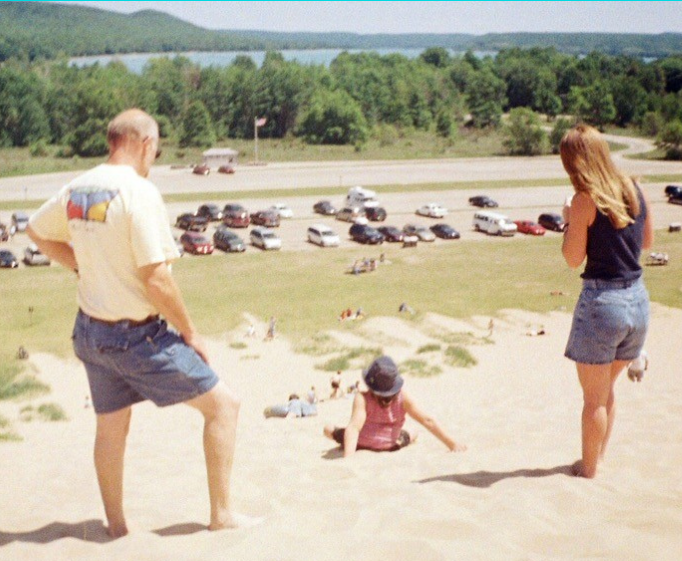Inclusion: It’s More Than Just Meeting the Rules of the Law or the Policy
by Beth

Liz sitting at top of a massive sand dune at Sleeping Bear Dunes in Michigan looking down at the landscape below after just having crawled the entire way up. Her grandpa and aunt are standing behind her after providing some assistance with the climb.
Guest blogger Liz Davis lives in Chicago and is an UX Designer at SPR. She has used a wheelchair all her life, and her experience in dealing with the obstacles of an environment lacking accessibility has granted her a useful perspective on inclusion. We are so fortunate to have her share her story with us today.
by Liz Davis
Inclusion is often thought of as a positive word, a word that is used to inspire connectivity, community and diversity. But inclusion means something different for me than it does for my neighbor.
Growing up as a wheelchair user, I was introduced to the idea of inclusion early on in life. Inclusion was my parents not stopping me from crawling out to the backyard to play in the dirt just like my siblings. Inclusion was my mother fighting with our local school district to get a wheelchair lift so I could attend sixth grade on the upper floor instead of them moving the entire grade because of me. Inclusion was going with my youth group to volunteer to New Orleans for volunteer hurricane relief despite the extra effort needed with a wheelchair.
I’ve been fortunate to have a lot of inclusion in my life, but it is just as important to talk about the subtle exclusions that come with being disabled — especially the exclusion that occurs when inclusion is intended, the sort of thing that can happen when trying to meet accessibility standards.
College was the first time I really started paying attention to these exclusive situations. I attended a university in an old Catholic college in Iowa, and the school’s buildings had been built long before the ADA. My dorm room was accessible, I could live independently, and the bathrooms were sufficient for me. By standards of the law it was an inclusive, accessible experience.
On the other side of the coin, the dorm buildings many of my friends lived in did not have elevators, and of course they lived on the highest floors. Technically they could have just come to my dorm to hangout, but social experiences are not so structured. I lived in a single dorm, not the large suite my friends did. They would help me up to the higher floors if we planned out a time to meet, but what if I had to use the bathroom? The feeling of not being able to freely leave when you’d like is not an inclusive experience either. I’d have to find a gap in the socializing to ask if they could help me downstairs, an awkward situation to say the least. Without an elevator available, just hanging out and socializing naturally couldn’t happen. I’d often feel left out.
I never blamed my friends, but this is where exclusion hurts the most. When you can’t speak up or change anything because technically the accessibility need was met. It’s not a reasonable accommodation to put an elevator in every single dormitory for one student in a wheelchair.
To me, inclusion is considering the social aspects of an experience in combination with the physical. It’s more than just meeting the rules of a law, or policy. Inclusion is providing the environment for someone with a disability to fully experience their lives.






